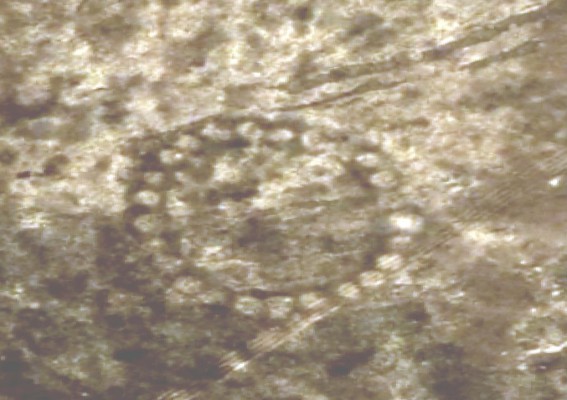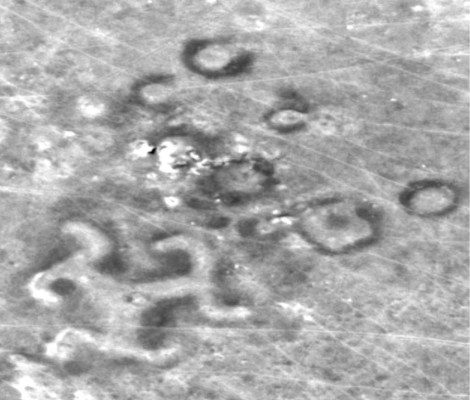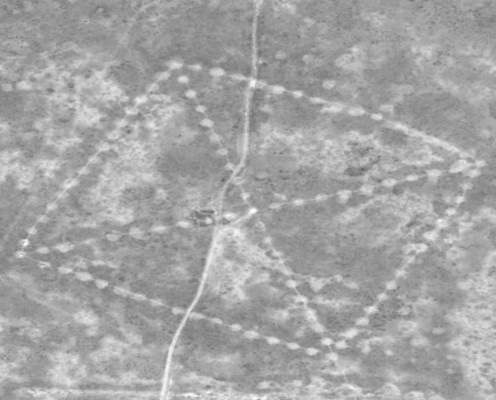NASA satellites have revealed ancient mysterious artworks on the surface of the Earth in the Kazakhstan in Asia.
The images have been beamed back to NASA from one of its satellites and they show rural areas with vast amounts of empty land, but the area shows large shapes in the earth from squares and lines to circles and many are the size of a professional football field. There is no other way that the shapes could be recognised aside from in the air looking down to the ground.
NASA scientists are saying that they believe they are ancient and could be as old as 8000 years. The biggest is located next to a known Neolithic site of more than 100 hill mounds and they are connected with a cross marked in the ground. Another land marking looks like a giant swastika.
The shapes are thought to be a new discovery never before seen from the air and undiscoverable on the ground. Archaeologists are now keen to study the sites so that they can better understand where they originate from. The shapes were originally first noticed in 2007 when a Kazakhstan native was studying his country on Google Earth.
The shapes and mounds have been called the Steppe Geoglyphs and still remain a mystery. Another of the shapes is called the Bestamskoe Ring with around 260 earth shapes and mounds, as well as trenches.
NASA has released new images of the site as some suspect that NASA might be launching an investigation into the site. (The New York Times)
NASA officials say that they have never seen anything like these earth formations and that they plan to start a project to map the entire area. They have also requested that astronauts at the International Space Station take more images. The space agency has become involved as researchers want the backing, funding and support from the agency in order to further the investigation. Researchers are interested since they don’t believe the shapes were ever intended to be viewed from the air, but instead believe they may have been drawn to track the movements of the sun.

The rich lands of the steppe were a destination for Stone Age tribes seeking hunting grounds, and Mr. Dey’s research suggests that the Mahandzhar culture, which flourished there from 7,000 B.C. to 5,000 B.C., could be linked to the older figures. But scientists marvel that a nomadic population would have stayed in place for the time required to lay ramparts and dig out lake bed sediments to construct the huge mounds, originally 6 to 10 feet high and now 3 feet high and nearly 40 feet across.
Persis B. Clarkson, an archaeologist at the University of Winnipeg who viewed some of Mr. Dey’s images, said these figures and similar ones in Peru and Chile were changing views about early nomads.
“The idea that foragers could amass the numbers of people necessary to undertake large-scale projects — like creating the Kazakhstan geoglyphs — has caused archaeologists to deeply rethink the nature and timing of sophisticated large-scale human organization as one that predates settled and civilized societies,” Dr. Clarkson wrote in an email.

“Enormous efforts” went into the structures, agreed Giedre Motuzaite Matuzeviciute, an archaeologist from Cambridge University and a lecturer at Vilnius University in Lithuania, who visited two of the sites last year. She said by email that she was dubious about calling the structures geoglyphs — a term applied to the enigmatic Nazca Lines in Peru that depict animals and plants — because geoglyphs “define art rather than objects with function.” Dr. Motuzaite Matuzeviciute and two archaeologists from Kostanay University, Andrey Logvin and Irina Shevnina, discussed the figures at a meeting of European archaeologists in Istanbul last year.
With no genetic material to analyze — neither of the two mounds that have been dug into is a burial site — Dr. Motuzaite Matuzeviciute said she used optically stimulated luminescence, a method of measuring doses from ionizing radiation, to analyze the construction material, and came up with a date from one of the mounds of around 800 B.C.
Meanwhile Kazakhstan is keen to protect the findings.

